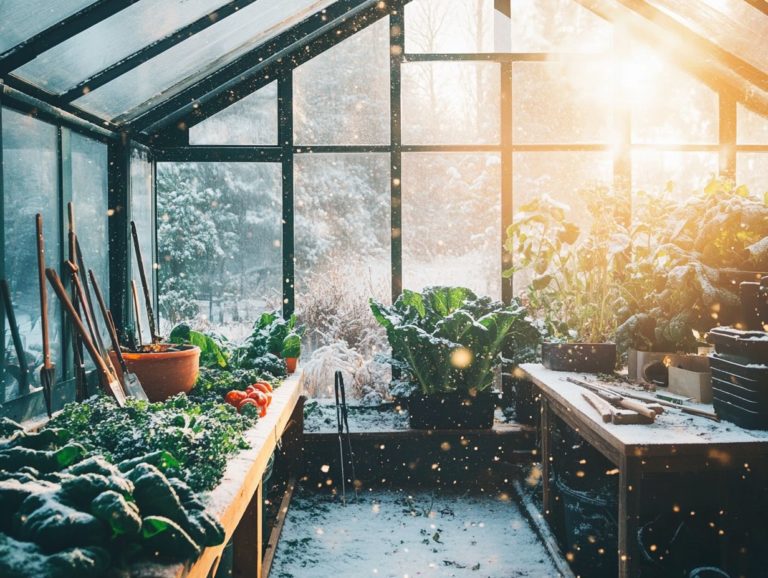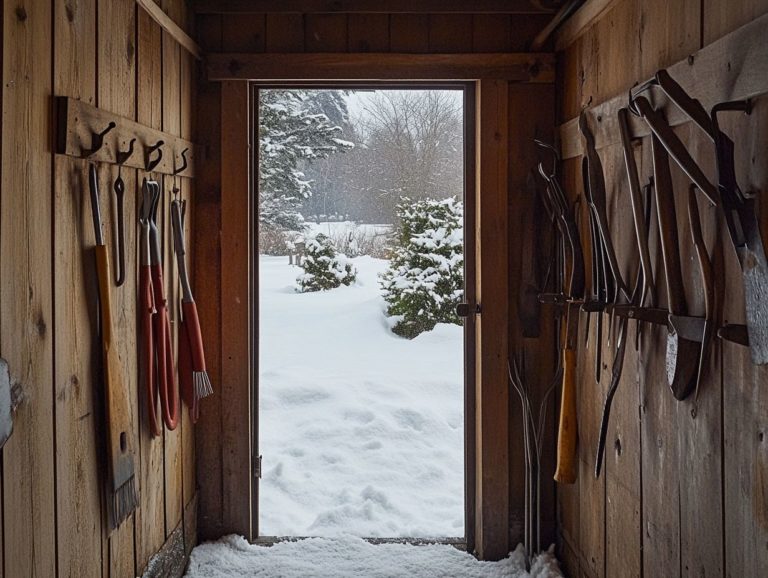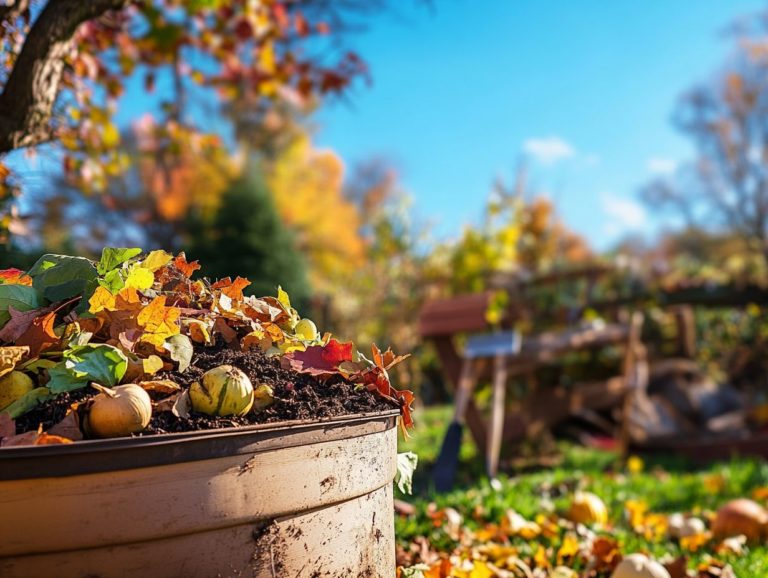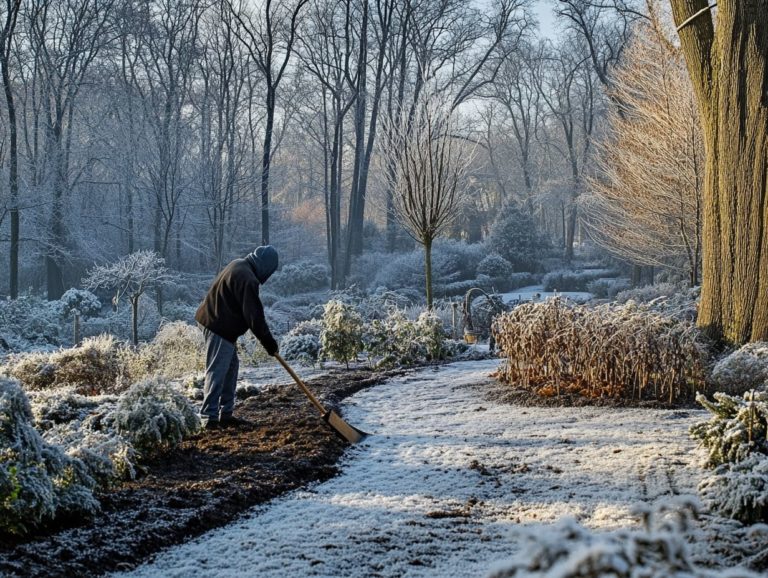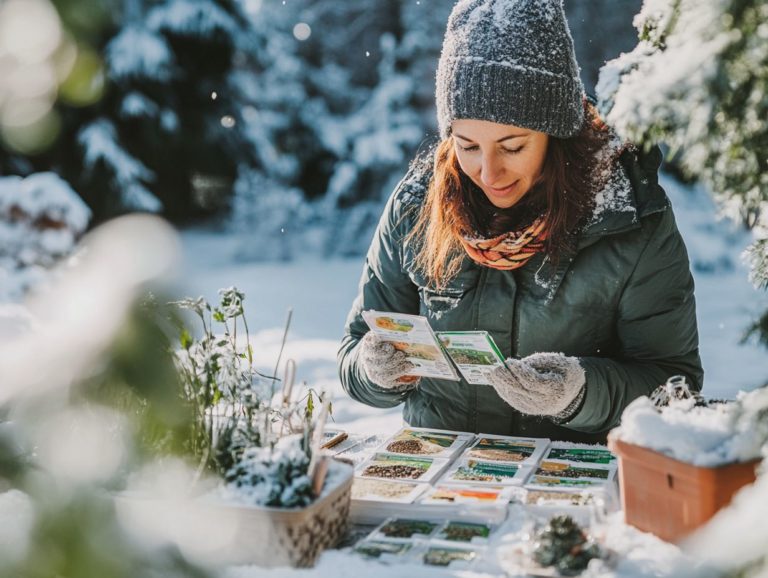Best Practices for Late Fall Planting
As the crisp air of late fall settles in, it s easy to hesitate about planting leafy greens, fearing that the chill will stifle growth. However, this season holds unique advantages for those who are bold enough to embrace it.
By selecting the right cool-season vegetables, preparing your fall garden thoughtfully, and mastering effective planting techniques, you can turn late fall into a fruitful season.
Let s explore the benefits of planting during this time, address common misconceptions, and offer practical tips to ensure your garden thrives even as temperatures dip.
Contents
Key Takeaways:
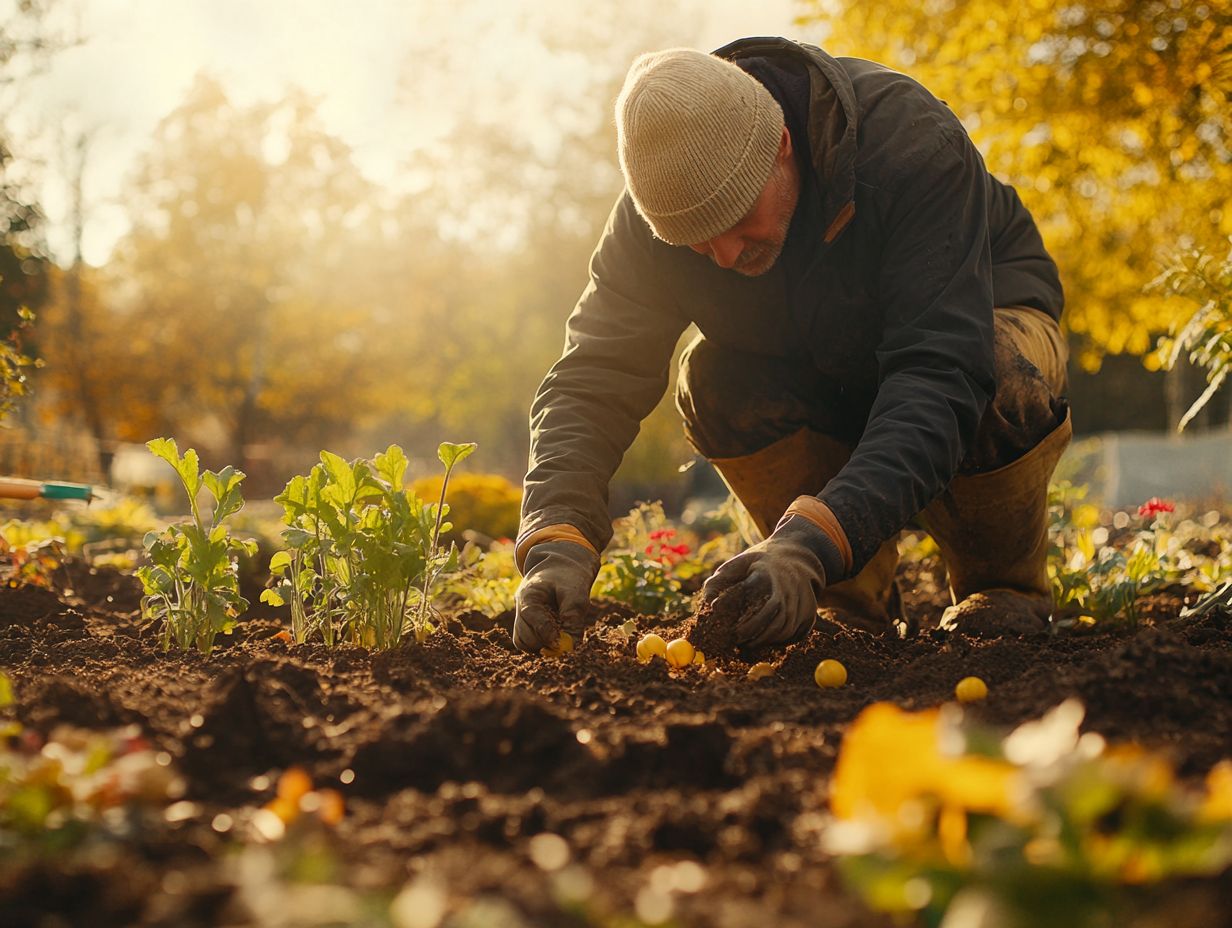
- Choose hardy plants, including perennials and shrubs, that can withstand cold temperatures for late fall planting.
- Properly prepare your garden and soil amendments for successful late fall planting.
- Protect your plants from frost, pests, and diseases during late fall for a healthy garden. Consider using moisture-retaining spray to support moisture retention.
Benefits of Planting in Late Fall
Planting in late fall presents a host of advantages that can significantly enhance the health and productivity of your garden, particularly when incorporating fall vegetables. To maximize these benefits, it’s helpful to know best practices for winter seeding.
As the air temperatures begin to dip, the soil stays warm enough to promote robust root growth. Delightful vegetables like kale, spinach, radishes, as well as arugula and broccoli, can flourish.
The moisture from autumn rains plays a crucial role in establishing your plants. Beneficial insects become active, fostering a balanced ecosystem that bolsters plant health and supports wildlife. Late fall planting leads to an earlier spring harvest of vegetables such as carrots, beets, and garlic, as your plants will be well-established and poised to thrive once warmer weather returns.
With all these benefits, late fall emerges as an ideal time to sow a diverse variety of vegetables, bulbs, and perennials in your garden!
Choosing the Right Plants
Choosing the right plants for your fall garden, including flowering bulbs like daffodils and tulips, is vital for cultivating a bountiful harvest and an inviting landscape. Focus on cool-season vegetables such as kale, spinach, and radishes, as well as microgreens, which thrive in cooler temperatures and actually benefit from the autumn rains.
Be sure to include perennials, cool-season annuals, and microgreens! They provide nutrition and add vibrant greenery to your fall garden. With careful selection, you can craft a resilient garden that not only continues to yield produce but also enhances your outdoor space during the cooler months.
Types of Plants Suitable for Late Fall Planting
Regarding late fall planting, you’ll find several types of plants that truly flourish in this season, bringing both beauty and nourishment to your garden when you follow the best practices for plant care in cold climates.
Kale stands out as a particularly impressive choice. Its remarkable hardiness allows it to withstand frost, and the cool temperatures actually enhance its sweetness, making it a favorite among leafy parts of the garden. Garlic, too, is a favored pick for late fall; once you nestle it into the soil, it benefits from the chill, paving the way for a robust harvest come summer.
Radishes are your go-to for instant gratification, maturing quickly and often ready to harvest within just weeks. Microgreens add a splash of vibrant color to your garden and can even be grown indoors if outdoor sowing isn t on the agenda.
Don t overlook perennials like winterberry, hellebores, and rhododendrons or azaleas. They not only brighten your landscape but also provide essential support for pollinators active in milder climates, enhancing the overall biodiversity of your garden. All of these selections ensure a bountiful harvest while enhancing soil health and providing vital resources for wildlife, including cover crops, creating a balanced ecosystem right in your own backyard!
Preparing Your Garden for Late Fall Planting
Preparing your garden for late fall planting entails several vital steps to create optimal growing conditions for your plants, including managing soil moisture. Start by cleaning and clearing your garden of any debris, dead plants, or clippings to prevent pests and diseases from settling in your soil for the winter. Using clippers will make the process easier.
Proper soil preparation is crucial. Consider testing soil temperatures and adding materials like organic matter to boost fertility and moisture retention. Adding a layer of mulch helps regulate soil temperatures and offers protection against frost and extreme weather, which is critical for your plants during winter.
By taking these steps, you set the stage for a flourishing garden when spring arrives, rich with blooms and vegetables.
Cleaning and Clearing the Garden
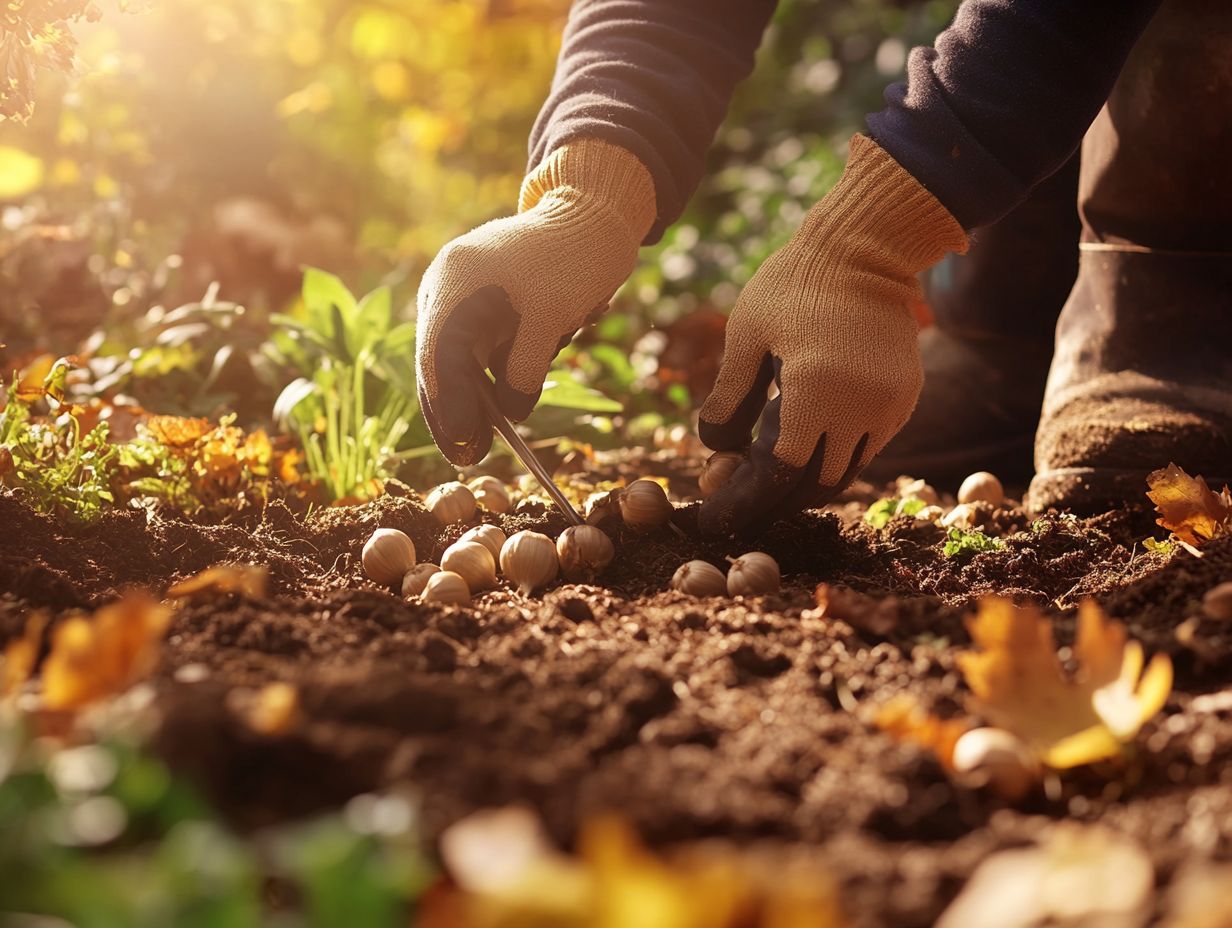
Cleaning and clearing your garden is a crucial step that lays the groundwork for successful late fall planting, especially if you plan to grow flowering plants. By removing debris like fallen leaves, dead plants, and clippings, you significantly reduce the risk of pests and diseases, ensuring the health of your late fall vegetables.
This practice not only looks great but also improves air circulation and soil health, creating a pristine environment for your fall vegetables, including cool-season annuals and perennials to flourish. During this cleanup, inspect your garden for any potential pest threats, especially with cool weather allowing pests to linger.
Keep an eye out for signs of infestation webbing, holes in leaves, or droppings and act swiftly to safeguard your plants from emerging pests or diseases. Incorporating some compost or organic matter into the soil can be a wise move as part of your cleanup efforts, enhancing moisture retention and soil fertility.
This addition helps maintain soil health for the upcoming planting season, ensuring your plants are well-prepared for growth. Don t overlook the benefits of mulching around your plants after cleaning; it s an excellent way to suppress weeds, improve moisture retention, and protect against frost as temperatures drop.
Soil Preparation and Conditioning
Proper soil preparation and conditioning are crucial for ensuring your late fall plants establish robust root systems and thrive in cooler temperatures. To enhance your planting success, consider following the best practices for planting in cold climates. Start by checking the soil temperatures to pinpoint the ideal planting time; warm soil encourages healthy root growth and ensures strong establishment of your plants.
Enhancing your soil with amendments like compost or organic fertilizers enriches its quality and improves moisture retention. These essential nutrients help your cool-season vegetables and perennials thrive even in the cold.
Along with checking soil temperatures, it’s vital to evaluate the current condition and pH level the measure of acidity or alkalinity in your soil which determines its fertility and how well your plants will thrive. This assessment guides you in selecting the most beneficial amendments, such as root starters, to promote healthy growth.
Incorporating organic matter, such as well-aged manure or leaf mold, significantly enhances soil structure and promotes moisture retention, crucial for your late fall planting efforts. For those engaged in late winter planting, using the best tools can make a difference. During the cooler months, maintaining adequate moisture is essential; it protects roots from frost damage and supports their development as plants, including cool-season vegetables, settle in.
By ensuring the soil remains moist but not waterlogged, you can set your late fall plants up for success as they adapt to the changing climate and cooler weather. Don t wait! Start prepping your garden today to ensure a vibrant spring bloom!
Planting Techniques for Late Fall
Employing effective planting techniques in late fall is essential for ensuring your plants develop strong roots before winter sets in. For optimal results, consider following the best practices for winter planting, especially for vegetables and perennials.
Focus on the correct planting depth and spacing. This allows each vegetable ample room to grow and access nutrients without the risk of overcrowding, ensuring a bountiful harvest.
After planting, consistent watering becomes critical. Keep the soil moist, particularly during dry spells, to nurture root growth and support the establishment of your crops.
Applying mulch around your plants insulates against frigid temperatures and retains moisture. This creates an optimal environment that promotes plant vitality throughout the dormant season for both your fall garden and spring blooms.
Proper Planting Depth and Spacing
Wondering how to get your late fall garden off to a great start? Understanding the right planting depth and spacing is crucial, especially with vegetables like kale, spinach, and radishes, as well as beans and corn.
Each vegetable has its own specific requirements for depth. For example, you should plant seeds at a depth that allows them to germinate effectively, particularly for crops like pumpkins or snapdragon.
Ensuring adequate spacing between plants promotes air circulation and prevents competition for nutrients. This fosters healthier roots and improves your yields come spring.
For kale, aim for a planting depth of about half an inch. Spinach thrives when sown one inch deep.
For radishes, plant them about one inch below the surface, spaced at least two inches apart to allow their roots room to grow. If you plant too shallow, your seeds may dry out or fall victim to pests.
Planting too deep can hinder germination, leaving seedlings struggling to break through, especially in colder climates. Improper spacing can lead to overcrowded plants that compete for light, water, and nutrients, compromising their health.
Paying attention to these details can profoundly enhance the overall vitality of your garden and improve your late fall harvest.
Watering and Mulching Tips
Are you ready to keep your plants thriving during late fall? Effective watering and mulching techniques are essential for ensuring they maintain the moisture necessary for strong roots and healthy growth.
It s important to water consistently, especially after planting. This helps the soil retain moisture and encourages healthy growth of both vegetables and perennials.
Applying a layer of mulch insulates the soil, shielding it from extreme cold temperatures and reducing evaporation. This dynamic duo of watering and mulching can transform your garden into a thriving paradise!
To maximize these benefits, consider watering early in the day when temperatures are cooler. This allows plants to absorb moisture before the warmer afternoon sun causes it to evaporate.
Using mulching materials like shredded leaves, straw, or wood chips helps maintain soil warmth and suppresses weeds that vie for valuable nutrients and moisture. The added layer of mulch creates a protective barrier against harsh winter winds, maintaining an optimal environment for soil health.
Make it a habit to regularly check soil moisture levels. This practice will guide your watering schedule, ensuring that root systems remain well-hydrated without becoming waterlogged.
Caring for Your Plants During Late Fall
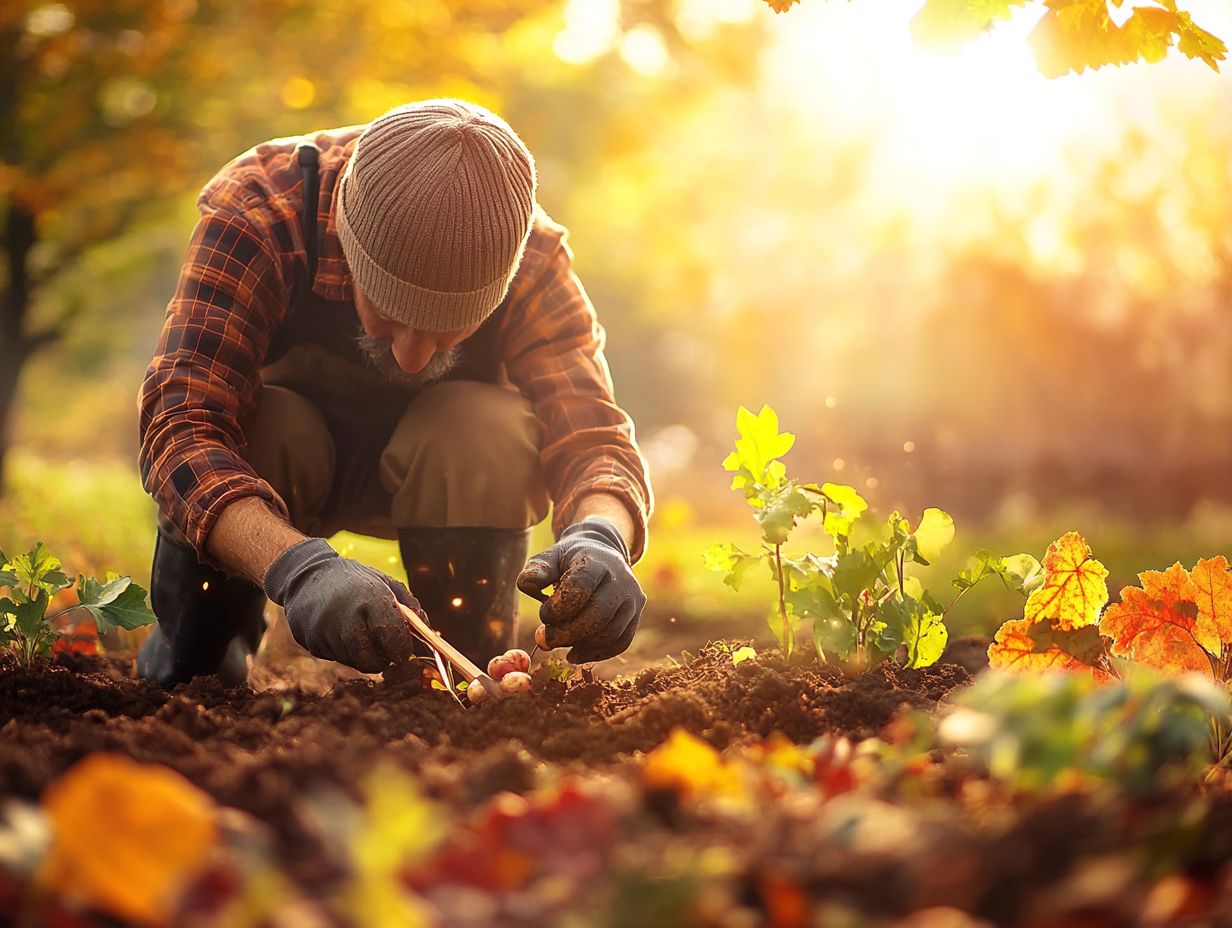
Caring for your plants in late fall demands an active plan to protect them from frost and cold temperatures while promoting their health. As nights get colder, stay vigilant with weather forecasts and take necessary steps to safeguard your plants from frost, especially young seedlings and delicate leaves that are particularly vulnerable.
Keep a watchful eye for pests or diseases that may arise with the changing weather. Be ready to implement preventative measures or treatments to keep your garden vibrant and healthy.
Protecting from Frost and Cold Temperatures
Protecting your plants from frost and cold temperatures is essential for their survival and vitality as the seasons shift. Late fall nights can catch you off guard with unexpected frosts, which can damage delicate foliage and stifle growth.
To safeguard your plants, use protective covers like frost cloths or blankets. These materials shield your plants from freezing temperatures and keep them insulated against the elements. You might also consider placing your pots in sheltered spots or clustering plants together to share warmth.
Selecting the right type of cover for each specific plant is crucial. Lightweight frost cloths are fantastic for light frosts, while heavier thermal blankets offer extra warmth for more vulnerable species.
For enhanced effectiveness, pair these covers with mulch or straw around the base of your plants to help maintain soil temperature. Creating a microclimate is another smart move; use hoops or frames to elevate the covers. This allows better air circulation while minimizing heat loss.
Implementing these strategies can significantly impact how well your plants thrive during the cold months. So act now to protect them.
Dealing with Pests and Diseases
Identify those pesky pests now to keep your garden healthy. Dealing with pests and diseases in your fall garden is crucial for ensuring a fruitful harvest. As temperatures drop, certain pests may become more aggressive, seeking refuge in your garden. Diseases thrive in the damp conditions that accompany this season.
Common pests like aphids and spider mites may appear, along with diseases such as powdery mildew that can devastate your foliage. Welcome beneficial insects like ladybugs that feast on harmful pests. Practicing crop rotation and clearing away debris can effectively disrupt the life cycles of pests and pathogens.
Make it a habit to inspect your plants regularly for signs of wilting leaves or unexpected discoloration. This vigilance enables early intervention, and using organic fungicides can tackle fungal diseases effectively. Stay proactive to extend your harvest season and ensure your plants remain vibrant and productive.
Common Misconceptions about Late Fall Planting
Several common misconceptions about late fall planting can prevent you from fully embracing this optimal window for sowing vegetables and perennials. Many might think that planting during the cooler months is a fruitless endeavor, but numerous cool-season vegetables actually flourish as air temperatures dip, especially when following the best practices for winter fertilization.
Some may believe that the soil is too cold for effective germination; however, soil temperatures can still be favorable for root growth and establishment. By understanding these misconceptions, you can confidently embrace late fall planting and refer to this guide on preparing soil for fall planting to apply effective techniques to cultivate a thriving garden.
In summary, stay alert and proactive in caring for your plants during late fall. Protect them from frost, monitor for pests and diseases, and embrace the opportunities for winter planting. Your garden will thank you!
Debunking Myths and Misinformation
It’s vital to debunk common myths about late fall planting. This knowledge helps you make informed gardening decisions. Many believe that planting during this season results in poor results, but the truth is that numerous cool-season vegetables like kale and spinach thrive in cooler temperatures.
Another misconception is that soil must be warm for seeds to germinate. However, many seeds can sprout just fine in cooler soils. By understanding the truth behind these myths, you can confidently adopt effective planting techniques for your late fall garden.
Some may worry that late planting could lead to diminished yields or stunted growth, but in reality, the right timing can lead to stronger, more resilient plants. Use proper mulching to protect your crops from frost. You can also use row covers, lightweight cloths that protect plants from cold, to ensure they develop healthily even in chillier climates.
Explore your late fall gardening options! Embracing strategies like succession planting and selecting hardy varieties can significantly enhance your productivity, especially when you consider the best practices for soil preparation in winter.
By shifting your perspective, you can unlock the unique advantages of extending the growing season into late fall. Ultimately, you ll reap a bountiful harvest that defies conventional wisdom!
Frequently Asked Questions
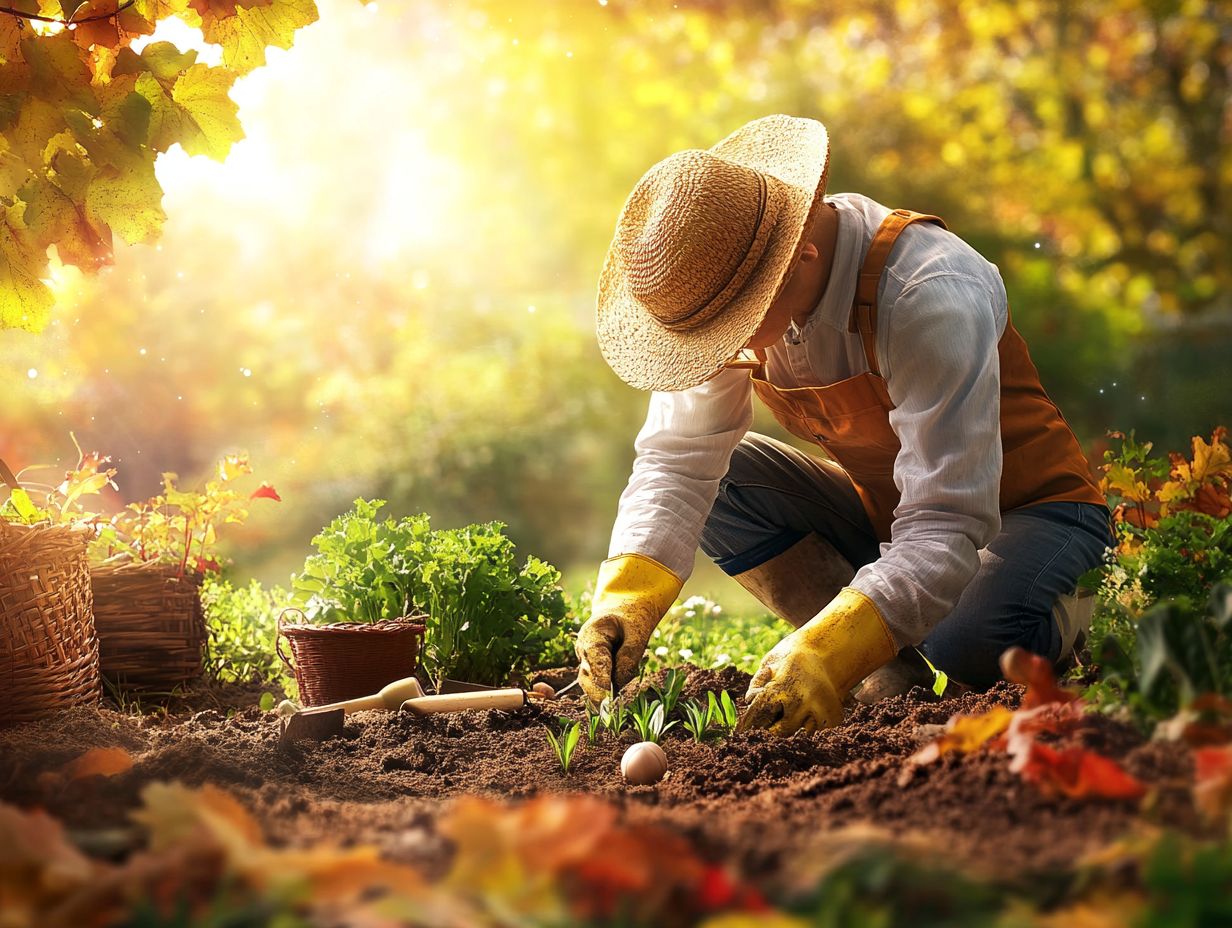
What are the best practices for late fall planting?
The following are some best practices for late fall planting:
- Choose cold-hardy plants that can withstand freezing temperatures.
- Prepare the soil by removing any weeds and adding compost or fertilizer for nutrients.
- Plant in an area with good drainage to prevent water from pooling around the roots.
- Water the plants deeply after planting to help them establish their roots before winter.
- Apply a layer of mulch to protect the plants from extreme temperature fluctuations.
- Monitor the weather and be prepared to cover the plants with blankets or burlap if temperatures drop below freezing.
Can I plant anything in late fall?
Yes! There are many plants that can be planted in late fall. Some examples include:
- Spring-blooming bulbs like tulips and daffodils
- Cold-hardy vegetables like kale, spinach, and carrots
- Perennials like coneflowers and peonies
- Shrubs like winterberry and holly
Is it too late to plant in late fall?
It depends on where you live and the specific plants you want to plant. In colder climates, it may be too late to plant certain plants in late fall. However, in milder climates, late fall can be a great time to plant. It’s best to research the specific plants you want to plant and consult with a local gardening expert for the best advice.
How do I protect my plants during the winter if I plant in late fall?
Here are a few ways to protect your plants during the winter:
- Apply a layer of mulch to insulate the roots and prevent frost heaving.
- Cover the plants with blankets or burlap if temperatures drop below freezing.
- Water the plants deeply before the ground freezes to prevent dehydration.
- Choose cold-hardy plants that can withstand freezing temperatures.
What are some benefits of late fall planting?
There are several benefits to late fall planting, including:
- Less competition from weeds and other plants.
- Plants have an opportunity to establish their roots before winter, leading to stronger growth in the spring.
- Many gardening stores offer discounts on plants in late fall, making it a more affordable time to plant.
- Colder temperatures and fewer pests can reduce the risk of plant diseases.
Can I still plant in late fall if the ground is frozen?
No, it is not recommended to plant in frozen ground. The ground needs to be workable for plants to establish their roots. If the ground is frozen, it is best to wait until spring to plant.

